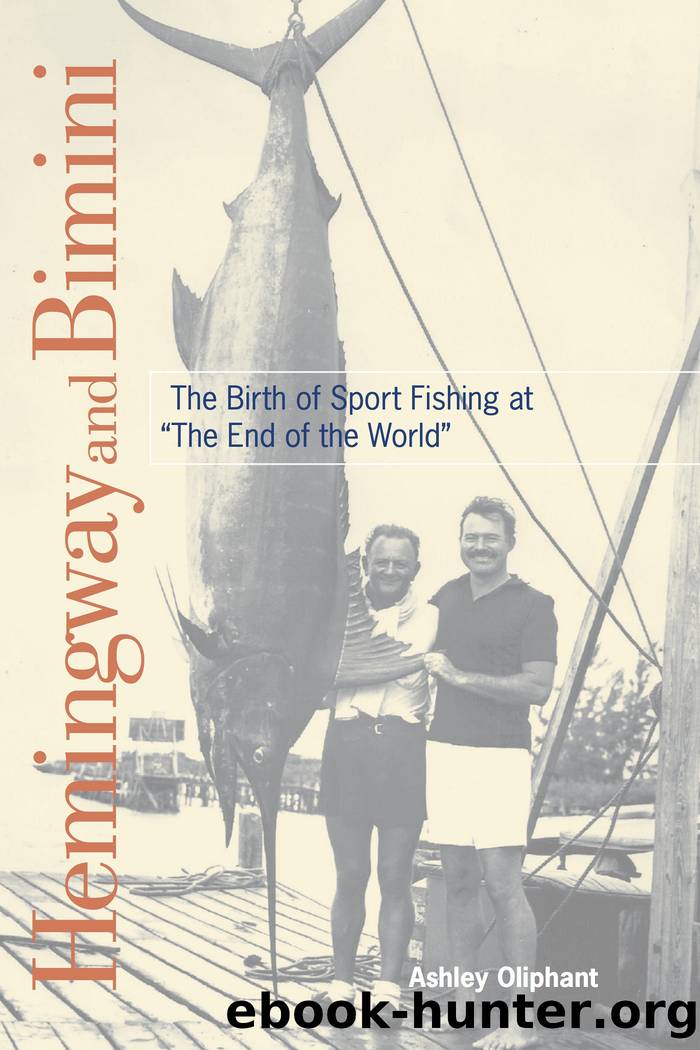Hemingway and Bimini by Oliphant Ashley;

Author:Oliphant, Ashley;
Language: eng
Format: epub
Publisher: Pineapple Press
Published: 2017-04-26T13:50:05+00:00
Hemingway and Carlos Gutiérrez show off the dayâs prize in Bimini in 1935: a 12-foot marlin.
IGFA Collection
In Hemingwayâs writing about fishing, the reader observes his concern as well for the most humane treatment of the hooked game fish. Now, I am not suggesting Hemingway was an animal welfare advocate. He dearly loved his pets, but he killed a lot of fish and other big game for sport in his lifetime. The way German contextualizes Hemingwayâs sporting activities is spot-on: âAsking him to be an animal-rights activist in 1940 would be like asking Buffalo Bill to be a vegetarian.â What Hemingway did, though, was demonstrate a very early regard for the humane death of the game fish. In âMarlin off Cuba,â he described angling as âa sport in which a man or woman seeks to kill or capture a fish by the means which will afford the fisherman the greatest pleasure and best demonstrate the speed, strength and leaping ability of the fish,â a creature which should then be killed âas promptly as possible [ . . . ] and as mercifully as possibleâ (70). Here Hemingway addressed the suffering of the injured animal and argued sportsmen should avoid wounding but not killing an animal. He advocated killing the fish âquicklyâ and âmercifully,â and he was willing, in what amounts to a Cuban fishing primer for aspiring anglers, to encourage them to treat game fish as humanely as possible. In his article âThe Great Blue Riverâ for Holiday magazine, he offered similar guidelines for handling big game in Cuba, instructing the fisherman to avoid hurting the animal during the fight and then to âclub [the fish] for kindnessâ (95). Clubbing a fish âfor kindnessâ might seem like an oxymoron, but when one considers the year in which this writing was published (1934 and 1949, respectively), it becomes clear these sentiments were profoundly important and should be included in any biographical consideration of Hemingwayâs character. In these pieces, he was taking a very public stand for a humane approach to a sport whose contests usually end in the death of the opponent. Many critics in my field over the past 40 years have seemed to be on a vendetta against Hemingway, vilifying his life and criticizing him at every turn, very often for faults that resulted from his being a product of his time period. Without providing historical and cultural context when biographical attacks are launched, the critic acts as unethically as he or she asserts Hemingway was.
If my appraisal of Hemingwayâs humane position did not persuade you, take it from Fidel Castro. In his autobiography Fidel Castro: My Life, the Cuban dictator claimed, âIf Hemingway had lived a few years longer, Iâd have liked to have time to talk much more with him. To become a little closer friends. [ . . . ] As a person, in the little I knew him, he seemed to me, in his habits, his practices, his things, a very humane personâ (Castro and Ramonet 592â593).
Download
This site does not store any files on its server. We only index and link to content provided by other sites. Please contact the content providers to delete copyright contents if any and email us, we'll remove relevant links or contents immediately.
Backpacker the Complete Guide to Backpacking by Backpacker Magazine(1830)
The Isle of Mull by Terry Marsh(1527)
Capital in the Twenty-First Century by Thomas Piketty(1430)
Predation ID Manual by Kurt Alt(1320)
The Collected Non-Fiction by George Orwell(1314)
Small-Bore Rifles by C. Rodney James(1276)
Creative Confidence by Tom Kelley(1149)
Backcountry Bear Basics by Dave Smith(1139)
All Fishermen Are Liars by John Gierach(1127)
50 Famous Firearms You've Got to Own by Rick Hacker(1110)
Blood Mountain by J.T. Warren(1102)
The Art of Throwing by Amante P. Marinas Sr(1085)
Archery: The Art of Repetition by Simon Needham(1072)
Long Distance Walking in Britain by Damian Hall(1058)
Backpacker Long Trails by Backpacker Magazine(1037)
The Fair Chase by Philip Dray(986)
The Ultimate Shooting Skills Manual: 212 Essential Range and Field Skills (Outdoor Life) by The Editors of Outdoor Life(972)
The Real Wolf by Ted B. Lyon & Will N. Graves(967)
The Ultimate Guide to Home Butchering by Monte Burch(953)
